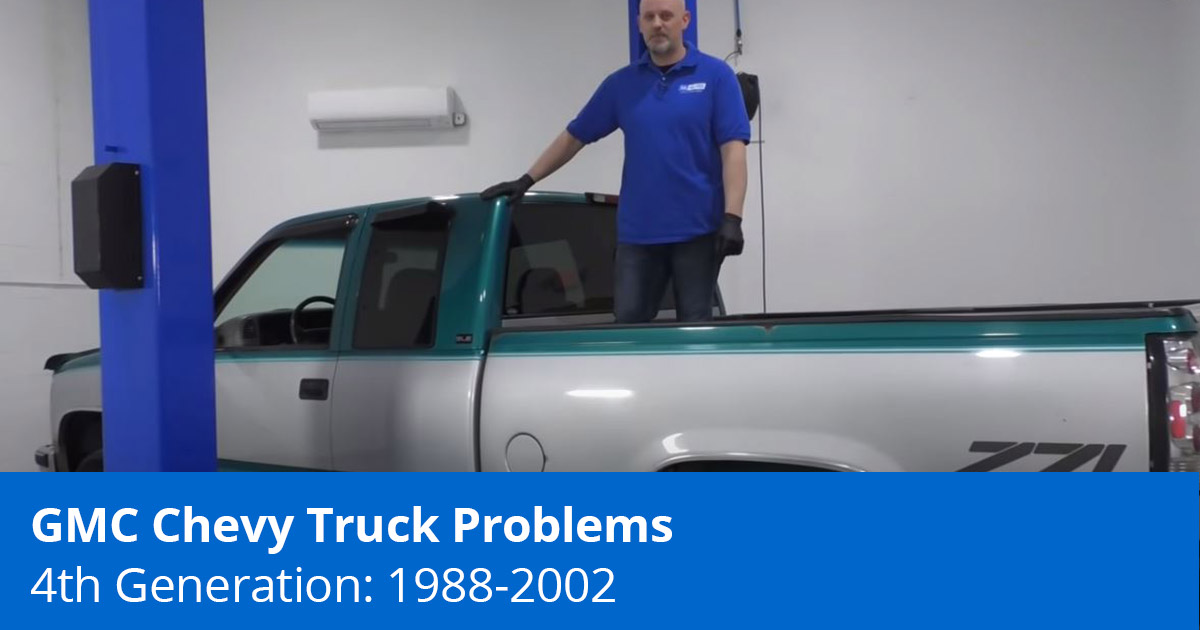2000-06 GMC Yukon and Sierra, Chevy Suburban, Tahoe, Silverado Avalanche, and Cadillac Escalade

Like many products on the market, cars experience considerable deterioration and damage as a result of normal use and exposure to external elements. GM is no exception when it comes to common GMC and Chevy truck problems. It’s therefore, normal for any car owner to repair something today, replace a car part tomorrow, or carry out regular service and maintenance.
In today’s post, we’ll take a look at 5 of the most common 2nd generation GMC and Chevy truck problems. These problems are the same for vehicles that ride on the same drivetrain – the HMT800. They include the Chevy Tahoe, Suburban, Silverado, and Avalanche as well as first-generation Cadillac Escalade.
Top 5 GM SUV and Chevy Truck Problems
1. Oxygen Sensors P0171/P0174/P0300
The oxygen sensor is a device that monitors your car’s fuel to air ratio. It lets the vehicle’s computer know when there’s less or too much oxygen in the fuel mix. This allows the engine to make changes so that the car can run as it should.
Oxygen sensors are identified by the side of the engine they serve and their positioning in the vehicle. Each side of the engine is referred to as ‘bank’. And as it is with V6 and V8 engines, you’ll find two sides identified as bank 1 and bank 2. Bank 1 houses engine cylinders 1, 3, 5, and 7 while bank 2 houses cylinders 2, 4, 6, and 8.
When it comes to the positioning of the oxygen sensors, sensor 1 and sensor 2 (also referred to as ‘upstream’ and ‘downstream’) are used to identify the front oxygen sensor and rear oxygen sensor respectively.
In the GMC Yukon and Sierra, as well as other GM trucks and SUVs mentioned above, you’ll find four oxygen sensors. Bank 1 sensor 1 is located on the driver’s side. It monitors the air-fuel ratio in cylinders 1, 3, 5, and 7. Bank 2 sensor 1 is located on the front passenger’s side and monitors the air-fuel ratio in cylinders 2, 4, 6, and 8.
Bank 1 sensor 2 and bank 2 sensor 2 are located on the rear part of the vehicle on opposite sides. They both monitor the catalytic converter. They do not change the air-fuel ratio and therefore, do not affect drivability or how the engine runs. When they are damaged, you’ll get a trouble code for the sensors themselves or the catalytic converter (P0171/P0174).

Symptoms of a bad oxygen sensor
When either of the front sensors is damaged, you may experience a drivability issue or rough engine. Sometimes, the cylinders on one side of the engine may all be misfiring. This will generate a P0300 misfire trouble code when you troubleshoot. A flashing check-engine light is also a common symptom here.
How to diagnose a damaged oxygen sensor
If you have a rough running engine or your vehicle is misfiring on one side, you most likely have an issue with one of the front oxygen sensors. This is one of the most common GMC and Chevy truck problems. Follow the steps below to diagnose a bad oxygen sensor.
Step 1. Switch off your vehicle and disconnect the oxygen sensor that’s located on the side where there’s a misfire.
Step 2. Turn the vehicle on to see whether the drivability issue is still there. Your vehicle’s computer should compensate for the missing sensor and run the car as it should. If it does, the problem is definitely with the sensor
Step 3. You can alternatively swap the two front oxygen sensors. If the drivability problem or trouble code shifts with the swap, your sensor is damaged and you’ll need to replace it.
Step 4. While diagnosing a bad sensor, it’s always best to check the wires and connector. If the wires are worn out or have their copper exposed, you’ll need to replace the oxygen sensor as wires cannot be repaired. Disconnect the connector as well and clean off any green material or corrosion.
2. ABS Activation at Slow Speeds
The anti-lock braking system keeps the wheels from locking up under heavy braking. This helps to maintain grip on the road and avoid skidding. In your GM SUV or truck, each wheel is fitted with an intelligent sensor that monitors its movement.
When the wheel is just about to lock up and come to an abrupt stop, the ABS system releases the brake for just a moment. It repeatedly and continuously applies the right amount of braking pressure to all wheels, allowing them to brake just enough to avoid locking up.
Symptoms and cause of ABS at low speed
Sometimes, you may feel the brake pulsating when you come to a halt at about 3-4 mph. You may even experience difficulty in stopping or notice that the ABS light is off. Driving with a faulty ABS sensor can be dangerous so this one of the common GMC and Chevy truck problems you fix immediately.
This is commonly caused by an ABS speed sensor that gets pulled away from the hub and tone ring/reluctor wheel due to rust buildup. When that happens, it sends information to the ABS module that the front wheels are traveling at different speeds and that one of them is slipping.
How to fix low speed ABS activation in Chevy trucks
To fix this GM problem, follow the steps below:
Step 1. Take off the brakes and locate the ABS sensor.
Step 2. Remove the sensor and clean off the rust underneath.
Step 3. Coat the area with primer or paint.
Step 4. Put the sensor back in.
3. Knock Sensor
The knock sensor turns the sound and vibration that comes from the engine block into electronic signals. It then sends these signals to your vehicle’s computer which determines whether ignition should occur immediately or be delayed. This helps to detect engine knock and correct it automatically.
Symptoms of bad knock sensor in GMC and Chevy Trucks
If you’re driving around with an engine knock, you may have a bad knock sensor that needs to be replaced. Most of the time, you’ll only get a check engine light or a P0327/P0332 trouble code. You may also get a drivability issue, but that’s rare.
How to replace a bad knock sensor
The GMC Yukon has two knock sensors located underneath the intake manifold and so do all the other vehicles running on the same drivetrain. To replace a bad knock sensor, follow the steps below.
Step 1. Disable the fuel system and disconnect the fuel line.
Step 2. Pull the intake out together with the snorkel.
Step 3. Locate both knock sensors and replace them. One is located at the front and the other at the back. Knock sensors are extremely sensitive so be careful not to drop or damage the new ones. Remember to torque them to the proper spec.
Step 4. When replacing the sensors, replace the wiring harness as well. This helps to fix any connector or wiring issues that you may have.
4. Oil Pressure Sensor
The oil pressure gauge shows the amount of pressure the oil has as it moves through the engine. It could show a wrong reading due to a bad PCM, a wiring issue, or a cluster problem that causes it to stick. This is one of the top 5 GMC and Chevy truck problems but will show you how to diagnose and fix it here.
Symptoms of a bad oil pressure sensor in a Chevy Truck
If you see your oil pressure gauge reading zero, or find it pegged at let’s say 80 psi or kPa, you may have a bad oil pressure sensor that needs to be replaced. GM trucks and SUVs have the oil pressure sensor located at the back of the engine behind the intake. You can get to it without having to take the intake off, but doing so makes accessing it a lot easier.
How to diagnose a bad oil pressure sensor
To diagnose a bad oil pressure sensor, you’ll first need to switch the car off and disconnect the connector at the sensor. If the gauge was pegged and suddenly drops to zero, the actual oil pressure sensor has shorted and will need to be replaced.
You could alternatively connect your oil pressure gauge directly to where the sender is and check the oil pressure. Where possible, you can use an oil pressure gauge adapter which is designed to connect directly to where the oil filter is located.
You’ll have to take down the filter, connect the adapter, and then push in an electrical oil sensor or gauge. If the gauge readings are still off, you could have an electrical problem.
5. Steering Intermediate Shaft
The steering intermediate shaft connects the steering wheel to the steering gearbox. It’s designed to telescope in and out so that the vehicle can turn easily and smoothly. When it’s not functioning properly, you’ll hear strange sounds whenever you turn the steering wheel or go over bumps.
One way to fix the strange sounds is to take out the steering intermediate shaft, grease it, and put it back in place. However, this will only last you about 5,000 miles. For a more permanent solution, it’s best to replace it entirely.
Bonus: GMC and Chevy Truck Problems – Grounding
Sometimes, you may have a weird electrical problem that you can’t quite figure out. To identify the source of such problems, you’ll need to check your wires and fuse box. Start by disconnecting your battery and checking the ground wires. They could be corroded or disconnected. If you notice that some of them are old and worn out, you’ll need to replace them.
Once you’re done with the ground wires, open the fuse box cover and check for evidence of rodents. Mice tend to chew stuff in there and leave waste material all over the place. This can cause fuses to stop working and in more serious situations result in four-wheel-drive issues.
Shop Parts in this Post:
- GMC Sierra Parts
- GMC Yukon Parts
- Chevy Tahoe Parts
- Chevy Suburban Parts
- Chevy Silverado Parts
- Chevy Avalanche Parts
- Cadillac Escalade Parts
Related Content:
- Common 07-16 GMC Acadia Problems
- Top 08-16 Chevy Cruze Problems
- Top 3rd Gen 07-14 Cadillac Escalade Problems
- Top 08-14 Cadillac CTS Problems
- Does Your GM Need a New Air Suspension Kit?


I have a 2004 gmc yukon my baby!!!! Well yesterday I put to much on her or her rear end was closw to warn out already. Yesterday I hauled a 2500lb trailer and 3 hours after wards prolly 30 miles. The truck started making serious noise sounded like motor ran out oil but it was the rear end the transmission stopped engaging when u put it in drive until u get to 2nd or 1st